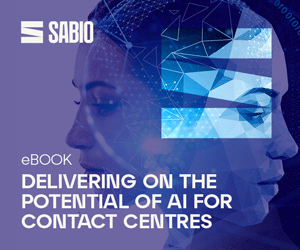Nicklas Klemm at Synthflow reveals how AI-powered call centre agents can transform customer service by automating routine interactions, enhancing efficiency, and delivering personalised, 24/7 support.
An AI call centre agent is a virtual assistant that uses speech recognition, NLP, and machine learning to understand and respond to customer calls in real time.
It handles tasks like answering FAQs, booking appointments, or checking order status, integrates with backend systems, works 24/7, and reduces human workload by automating high-volume, repetitive interactions.
AI-powered call centres work continuously, managing multiple queries at once without missing calls. They improve efficiency, reduce costs, and lower error rates.
With NLP and machine learning, these systems handle interactions quickly and accurately, scale as needed, and maintain consistent service across channels.
Benefits of AI Call Centre Agent
Continuous Availability and Scalability
AI voice agents ensure contact centres are always available, answering calls instantly 24/7. Users no longer worry about opening hours or agent availability, with a 42% improvement in accurate call routing.
Enterprises can answer calls en-masse, running multiple concurrent calls. Imagine multiplying the productivity of your contact centre to the equivalent of 100 agents answering calls concurrently.
Lower Operational Costs
By 2026, artificial intelligence is expected to reduce call centre operational costs by $80 billion. Automated customer service systems can handle routine customer interactions, minimizing the expenses tied to recruitment, training, and salaries.
Virtual agents cut hold times and allow for en-masse concurrent function calling. In addition, they eliminate human error, guaranteeing consistent customer service. Fewer human-agent interactions also lead to faster resolution times, further reducing operational costs.
Enhanced Customer Service
AI call centres improve customer experience by providing personalized and efficient service. With the help of natural language processing, AI phone agents can understand context, with advanced programs even able to detect emotions in a caller’s voice.
Customers don’t waste hours on hold or being transferred between agents, repeating their queries and waiting to get help.
They get answers to their pressing questions quickly and immediate attention, rapidly improving their experience.
Contact centre automation ensures smooth, consistent service delivery, reducing the workload on human agents and improving operational efficiency.
Plus, the intelligence can quickly and proactively route them to the right live agent who can help with their specific query.
Platforms create conversations that feel natural and human, with a touch of emotion. Virtual agents handle personalized and helpful interactions, freeing up your team to focus on more challenging tasks.
Data-Driven Insights
AI call centres offer real time insights into customer interactions. This data helps businesses understand customer needs, emotions, and challenges, making it easier to improve their service.
Platforms can allow you to access past call logs and view customer insights and preferences mid-call. The intelligence uses this information to predict future caller intent and provide personalized, relevant recommendations to agents.
This approach helps businesses make better decisions that benefit their customers and improve their results. With AI call centres, companies can spot trends in customer behaviour, predict future needs, and offer solutions before problems occur.
Key Features of Voice Agents in AI Call Centres
Natural Language Processing (NLP)
Voice synthesis is the cornerstone of relatable, human-like AI in customer service. Powerful call center AI solutions use natural language processing (NLP) to understand speech and respond naturally, ensuring a more seamless conversation.
NLP uses complex algorithms to analyze speech patterns, recognize intent and context, and generate appropriate responses.
This technology allows AI voice agents, AI receptionists, and AI concierges to understand and respond to customer queries, complaints, and requests in real time without the need for any human intervention.
AI-Powered Conversational IVRs
Interactive Voice Response (IVR) AI in a call centre make tasks such as call enquiries, feedback surveys, follow-ups and bookings easy.
Traditional IVRs already reduce human assistant calls by 10% and boost CSAT scores by over 5x. Weaving AI into the mix takes this a step further.
Rather than a hierarchical menu of options, AI IVRs use NLP to offer the right, curated information and options based on a predetermined trigger. For instance, if a customer says “help with my account,” the IVR will automatically recognize their intent.
The AI can automatically provide them with detailed account-related information, or transfer them to a human manager if needed. This not only reduces wait times for customers but also decreases the workload for call centre agents.
Predictive Analytics and Customer Insights
Using virtual call centres allows businesses to harness the power of AI predictive analytics to better understand customer behaviour and needs.
By analysing past interactions and consumer data, AI systems notice patterns. This use of AI for call centres ensures service is both reactive and proactive, addressing concerns before they even arise.
Intelligent Call Routing and Optimization
Using AI to automate call routing cuts out the middleman and saves your agency a lot of time. Voice assistants can define your call using caller details, the reason for their call and more.
Some platforms use mid-call APIs to gather data from customer interactions and determine the best course of action.
The intelligence employs NLP to recognize trigger words and automatically route the call to an appropriate agent, speeding up resolution time and improving overall customer experience.
Multi-Channel Integrations
The ability to integrate call centre AI with various platforms and systems allows for a more streamlined and efficient customer service experience. CRM integrations.
How an AI Call Centre Can Improve Efficiency and Customer Service
Reduce Call Handling Times
A decent handle time is around six minutes. Implementing AI into calls can shorten handling times, using functions like automated call routing, virtual assistants, and data analysis. Customers get their calls answered a lot faster, an essential factor in customer satisfaction.
Handle High Volumes Without Delay
Solutions for call centres need to handle large concurrent call volumes. Call centre representatives are often held to the 80/20 rule, where 80% of calls are answered in the first 20 seconds.
Traditional call centre employees answer 50-100 calls daily, often talking for up to 10 minutes at a time. Backlogs are normal, and as little as 16% of traditional call centres can reach the 80/20 target.
A fully staffed contact centre with 50 agents could handle up to 5000 calls daily. Software can handle 100 calls concurrently and answer tens of thousands of calls in the same period of time.
Even when there is a surge in call volumes, software can easily handle high traffic without delays or interruptions thanks to low latencies in calls of just 700ms.
Sentiment Analysis for Personalized Experiences
Many call centre AI software agents use sentiment analysis to detect customer emotions during interactions. Picking up on cues like tone of voice, word choice, and language patterns, AI analyses customer sentiment.
Imagine multiplying the productivity of your contact centre by 100 agents answering calls concurrently, without any additional overheads.
This personalization not only improves the customer experience but can also cut costs by up to 30% through more efficient call management.
How to Use AI Call Centre Agents: Best Practices for Implementation
How do you implement an AI-powered solution that revolutionizes your call centre operations? Here are the best practices for implementing AI that leading call centres in 2024 use:
Define Clear Objectives and KPIs
Setting clear goals, like improving your call centre efficiency or exceeding CSAT targets, help call centres to implement the right workflows.
Whether the focus is on reducing operational costs, improving efficiency, or boosting customer satisfaction, having measurable targets helps guide the rollout.
If call centre managers want to deliver tangible results when using AI to automate calls, SMART KPIs are important.
For example, a clear objective for AI deployment could be to reduce average handle times by 30% within the first three months of implementation.
Seamless Integration with Existing Systems
Implementing AI in call centres is a lot easier if your chosen platform has omnichannel integrations. Integrating AI with CRMs, knowledge bases and other platforms should be seamless.
You don’t want to spend hours coding and customizing for integration. Make sure to choose a contact center AI software provider that offers flexibility and ease of integration with your existing systems.
Continuous Monitoring and Improvement
Using artificial intelligence to enhance call centre operations involves continually monitoring and updating your models. Consumer needs are ever-changing, and your business objectives evolve as well.
The best contact center AI solutions provide continuous updates, offering new tools and features to meet market demands.
To effectively implement this, conduct monthly reviews of call handling times and track customer feedback scores.
For example, monthly reviews of metrics such as customer satisfaction scores and escalated cases reveal areas for AI optimization, enhancing both performance and customer experience.
The benefits of using AI in the call center should be reflected in your KPIs, so monitor how having calls handled by AI impacts key metrics like call volume, handling time, and customer satisfaction scores. Regular evaluation is crucial for adapting AI to changing customer needs.
Human-AI Collaboration for Complex Cases
Combining AI with human agents in the call centre means a seamless service when dealing with complex or sensitive customer issues.
AI voice agents can handle the routine stuff, so human agents can focus on the tricky ones that require empathy and nuance.
By picking up on keywords or detecting frustration in a customer’s tone AI can route the tough ones to skilled human agents.
This means customers get the right support and a balanced workflow between tech and human instinct. This collaboration also improves customer satisfaction and call center efficiency.
Customer Data Security
In the world of AI in call centres, customer data security is top priority. Privacy and security means using robust data encryption and adhering to relevant privacy laws like GDPR and CCPA.
Addressing these security needs is key to building customer trust as it means customers know their personal info is being looked after.
A strong security framework also minimizes the risks of AI in customer interactions and creates a safe and trustworthy space for businesses and their customers.
Future Trends in Call Centre Space
Emotional Intelligence in AI
Automated call centre solutions rely on context awareness and language synthesis to deliver adequate responses. AI technologies are rapidly innovating, and a focus of centre AI software is improving the natural, human-like communication of intelligence.
Emotional intelligence, which involves the ability to understand and respond appropriately to emotions, is an emerging trend of AI in contact centres. Empathetic accuracy is one-way providers are looking to improve calls.
Referring to the ability to accurately identify the emotions of another, it’s pivotal in AI-powered calls as it helps agent performance.
Empathetic accuracy helps the voice assistant identify correctly whether a customer is sad, angry or thrilled and responds accordingly.
As emotional intelligence in AI evolves, industries like healthcare and finance will see even more personalized and empathetic customer interactions, leading to higher satisfaction and loyalty. This shift will make voice agents more effective at building rapport and resolving issues with precision.
Real-Time Language Translation
The need for real-time language translation is growing in an increasingly globalized world. The translation NLP market is set to grow by over 25% by 2030.
This tech uses text-to-speech to turn conversations into a translatable script. Breaking down language barriers, call centres can offer dynamic, multilingual support without needing to employ translators.
Contact center operations benefit significantly from the ability to offer multilingual communication. Voice AI can help users browse menu information, make reservations, see available appointments, check opening times and make purchases, all in their language of choice.
AI-Driven Self-Service
Self-service is a key focus, with 90% of contact centre leaders looking to invest in user-driven capabilities within the next few years. When users can answer queries by themselves without speaking to a person, efficiency is optimized.
Chatbots, automated IVR systems, and other generative AI tools are being implemented to boost customer-operated contact flows.
Using context recognition to understand customer intent, the AI generates detailed responses to common queries.
Voice assistants are a key part of AI-powered self-service. Unlike pre-recorded, static menu response calls, AI agents can have dynamic, emotive conversations. This technology is already being used in healthcare.
Conclusion
As technology advances, businesses that embrace these innovations are seeing vastly increased efficiency and customer satisfaction.
With Voice AI, you don’t just streamline operations; you’re enhancing the customer experience by providing accessible, responsive, and personalized interactions.
By adopting these cutting-edge solutions, companies position themselves at the forefront of a rapidly evolving digital landscape, ensuring they meet and exceed the expectations of today’s tech-savvy consumers. The future of customer service is here, and it’s powered by intelligent, voice-driven solutions.
Author: Synthflow
Reviewed by: Megan Jones
Published On: 20th Aug 2025
Read more about - Guest Blogs, Synthflow





































